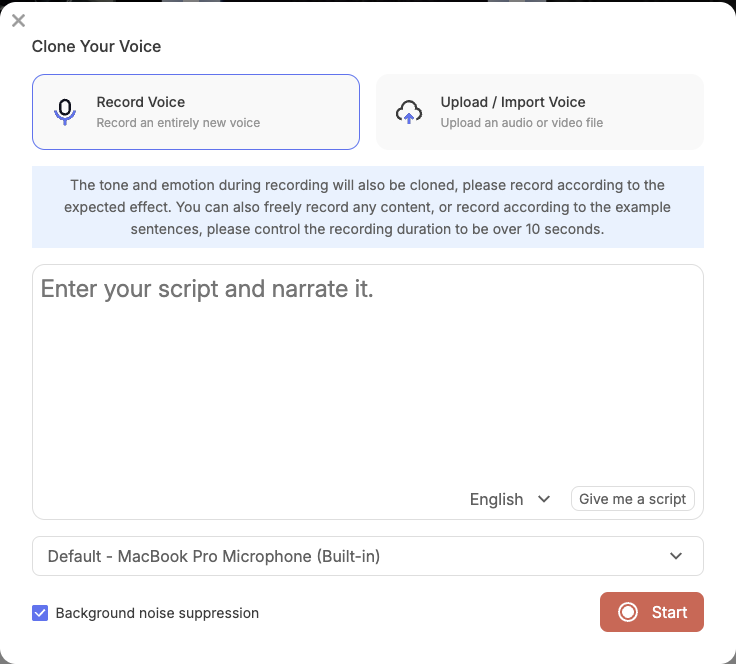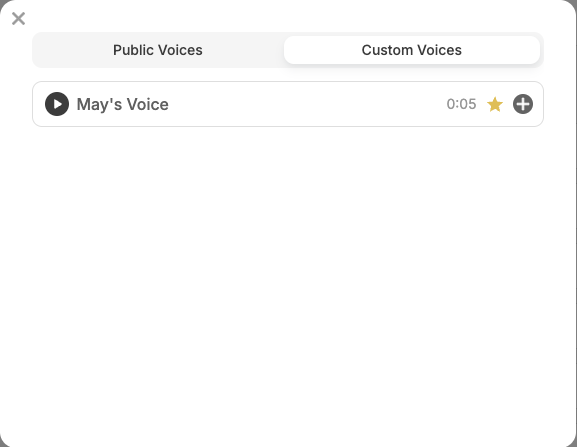Let me start with a confession: I work at Visla. I do content marketing, which means I’ve known about our AI voice cloning feature since the first murmurs of it hit our daily meetings. So, no, I wasn’t shocked when it launched. But what I didn’t expect was how weird it would feel to hear my own voice come out of a machine. Not just any machine—Visla.
Let me back up. As part of the content team, I test pretty much everything we put out into the world. From our new video effects to our powerful recording tools, I like to know what I’m talking about when I write about it. That includes testing other tools, too: ChatGPT, Gemini, you name it. But there’s something about testing your own cloned voice that’s just…different.
So here it is: my personal account of using Visla’s voice cloning tool and hearing an AI version of me speak for the first time.
The setup (spoiler: it’s super easy)
Cloning your voice in Visla is as easy as clicking a button. Literally. You click the “Clone Voice” button in the left-hand sidebar and follow the prompts. It’s impossible to miss. From there, you can either upload a clip of your voice or record it live. I chose to record, because I don’t exactly have a stockpile of high-quality audio clips lying around.

I used my trusty Blue Yeti X microphone. (No, this isn’t sponsored. Yes, it’s a good mic.) Visla even provides a script for you to read if you’re blanking on what to say. I, being me, went rogue and pulled up the infamous “Rainbow Passage” (if you know, you know). I also kept background noise suppression on, because I do not live in a professional sound booth. Once I finished, Visla generated my voice clone within minutes.

The first listen
Now, I don’t mind hearing recordings of myself. I’ve done some voice training in the past, so I’m used to listening back critically. But hearing the AI version of me? That was different.
It sounded like me. The tone, the cadence, the pacing. It captured a lot. And yet, my brain still went, “This is… not you.” Like listening to a really good impressionist.
And the wild part? Most of my friends couldn’t tell the difference. I tested them. Played them clips of real me and AI me. The responses were always some version of: “Wait. Was that you?”
Putting “my” voice to work
Then came the moment I added my voice to a Visla video project. I picked a clip, chose to use my own AI-cloned voice, and hit play.
And there I was. Sort of. It was me narrating, but also not. I didn’t have to record a single line. I didn’t stumble over any phrases. I didn’t lose my place on a teleprompter (not that I’d ever do that…).
That AI voiceover got the job done. Fast.
Why voice cloning changes everything
Recording good audio is hard. Even with a teleprompter, even with practice, even with a good mic. There’s setup time. You have to get into a groove. You have to redo takes. Sometimes your voice just doesn’t cooperate.
With voice cloning, all that friction disappears. You can still sound like yourself—your real, unique self—without the hassle. And you can do it in Visla, the same platform you’re already using to create and edit your videos.
For business use, this is massive. Marketing videos? Explainers? Executive intros? All of those can get a whole lot easier to produce. Especially when you want consistency in your tone and delivery. AI voice cloning also means that once you’ve created a good script, you can generate voiceovers instantly without having to schedule recording time.
And because it’s all in Visla, you can pair your AI voice with all the other magic: AI suggested B-roll and background music, fun text and graphic options, and easy branding elements. (Yes, I’m biased, but seriously: it works.)
Final thoughts
Do I still feel a little weird hearing my AI voice speak a script I wrote? Yes. Am I getting used to it? Also yes. Would I use it again? Absolutely.
Because at the end of the day, anything that helps me (and our team) produce better content faster is a win. Especially if it still feels like me.

